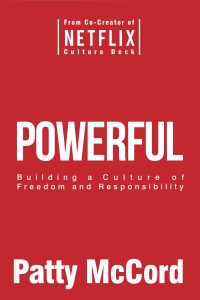
1. Everyone should understand the business-
Successful team accomplishments are made by all team members understanding the ultimate goal and being permitted to creatively solve problems to get there. A business will become rigid if employees regularly seek higher-level approval whenever a decision needs to be made.
2. Adaptability is key-
Without hesitation, Netflix adapted to the growing and changing needs of its customers, and welcomed the transition from DVD rentals to online streaming service. This was possible because Netflix chose not to follow the traditional route.
3. Give freedom and responsibility-
Netflix has much lesser rules than many other organizations because they believe in giving their employees freedom. But remember, freedom only works when accompanied by the obligation of accountability.
A culture of responsibility is the most valuable and is highly stressed throughout the book. Competition is healthy. Unlike a decade ago, employees rarely had any contribution in the process of decision making. But in modern systems, all parties get a view of the situation and share their insights. Every candidate, employee, or manager aims to understand the whole situation.
Freedom of expression
-Not all employees are fond of constructive criticism but by building such a culture, they might grow to embrace transparency. Radical honesty enhances communication.
-Netflix has a built-in feedback system for employees to share their insights and present their annual analysis.
-Debates between smaller groups bring a change in the organization because of the input. Since they are not inclined to group thinking, it opens a path to different possibilities and outcomes.
Hire the right people
-Pay less regard to the resume and observe the body language
-Determine if the candidate is a good fit for the team
-Evaluate their motives for joining the organization
-Determine if the candidate succeeds in problem-solving
-Acquiring a big shot should not be criteria. Instead, desire someone whose skills, character and determination can be applied to the team’s vision.
Managing the employees
An organization cannot operate strongly when it’s flooding with underachievers. A common and prevailing mistake is that organizations hire people for a position that doesn’t suit their expertise. A leader must oversee if the managerial hierarchy is properly structured.
Companies should consider paying best in the market for the positions that are the most valuable to the organization. Another common blunder managers make is factoring only what the organization can afford in terms of salary. Try also considering the value that new hires will generate.
# Key Takeaways:
– Power is not a negative concept, but rather a necessary tool for success in leadership and management.
– The key to using power effectively is to balance it with empathy and humility.
– Building and maintaining relationships is crucial in wielding power and achieving goals.
– Power can be used for both good and bad purposes, and it is important to be aware of one’s intentions and impact on others.
# Practical Application:
– Leaders and managers can use the concept of power to understand their own strengths and weaknesses, and how they can use their power to influence others positively.
– The strategies outlined in Powerful, such as building relationships and balancing power with empathy, can be applied in real-world scenarios to create a positive and productive work environment.
– By understanding the potential consequences of using power, individuals can make more informed decisions and avoid abusing their power.
# Valuable Insights for Leaders and Managers:
– Chapter 3, “The Power of Relationships,” offers valuable insights on how to build and maintain relationships in the workplace.
– Chapter 5, “The Power of Humility,” discusses the importance of humility in leadership and how it can enhance one’s power.
– Chapter 7, “The Power of Purpose,” explores how having a clear purpose can guide one’s use of power and lead to more meaningful and impactful actions.
# Case Studies and Examples:
– The case study of Abraham Lincoln in Chapter 2 illustrates how he used his power to unite a divided nation and achieve his goals.
– The example of Steve Jobs in Chapter 4 showcases the negative consequences of using power without empathy and humility.
– The story of Nelson Mandela in Chapter 6 demonstrates the power of forgiveness and how it can be used to bring about positive change.
Leave a Reply